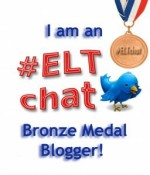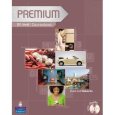What differences do you notice between the following two extracts?
I don’t think there’s any doubt that the way we live now- we have to change somehow, um, you know. We’re gonna end up with- with no water, with no heating, with- with nothing if we don’t change the way that we all live, so I think the point that he’s making about um homes being smaller um so that we can afford to heat them and to have water for them and, you know, different furniture and things like that is a really great idea.
I don’t think that there’s any doubt that we have to change the way we live now. If we don’t change, we’re going to end up with no water, no heating, with nothing, in fact. So, I think the point he’s making about homes being smaller, so that we can afford to heat them, and have water for them, is a great idea.
The first example comes from a semi authentic recording we made for New Total English Intermediate. The second is a ‘cleaned-up’ version. It’s been cleaned up by trying to simplify the syntax a bit, removing repetition and hesitation and taking out some of the markers and fillers.
The second version is perhaps more representative of a typical scripted dialogue (though things are changing, as we’ll discuss later); the first version is certainly more representative of how people actually speak.
In his article, ‘Lessons from the analysis of chunks‘, Michael McCarthy makes the point that two word chunks such as ‘you know’ ‘I mean’ and ‘kind of’ are actually much more frequent than many very common words such as ‘their’ ‘where’ or ‘friend’.
These high frequency chunks have a central part to play in communication. Some are often referred to as ‘fillers’. They can certainly act as ways of holding the floor while we think what to say next, but many high frequency chunks also have other clear pragmatic uses:
Referring to or checking shared knowledge: you know, you know what I mean.
Clarifying: I mean, like
Hedging (being indirect so as to save the other person face): I think, kind of, I don’t know if, a little bit, quite, actually, sort of
Vagueness: and things like that (see above example), a couple of, something
Everyday speech is full of these kinds of features, so aren’t we doing our students a disservice by presenting them with too sanitized a version of spoken English?
Alex Gilmore, in the article ‘A comparison of textbook and authentic interactions.’ finds that dialogues in the newer coursebooks (in 2004, when the article was published), ‘are beginning to incorporate more natural discourse features.’. I don’t think there’s any doubt that this trend has continued, and, furthermore, there is a recent move towards using more authentic or semi authentic material (such as in New Total English or Speakout).
It is certainly possible to have too much authenticity, and some transcripts of real conversations are pretty much unintelligible, but I don’t think there’s any doubt that including these features in recordings helps learners in processing real life interactions.
Getting students to ‘notice’ markers, fillers and hedging.
Obviously when students are listening to a recording, they are generally focused on picking out the key elements of meaning. However, we can focus on these high frequency chunks as a follow up task.
– Just as I did at the beginning of the post, you can rewrite part of an authentic transcript in a ‘cleaned up’ way and ask students to find the differences.
– Alternatively, give out the ‘cleaned up’ transcript and ask students to listen and write down any extra words or phrases they hear.
– Or, if you can make your own recordings, you could record a semi authentic dialogue, and then a scripted version of the same conversation and ask students what differences they notice.
– Give out cards with the high frequency chunks on, and ask students to hold them up whenever they hear ‘their’ chunk. (In some discourse the student with ‘you know’ may get quite tired arms..)
Encouraging students to use markers, fillers and hedging.
The first thing to say is that it is probably more important for students to be aware of these chunks than it is for them to be able to use them all.
However, many of these high frequency chunks can be very useful in gaining a little time to think when speaking, while still sounding fluent. Equally, not using hedging or vagueness can make discourse seem very brusque and even a bit aggressive or rude.
Here are some examples of very frequent chunks which I think learners could benefit from being able to use productively:
Well,..
Anyway,..
a bit
you know what I mean
and things like that/and stuff like that
a lot of people
there’s a lot of
I don’t know what/how/if
First, learners need to hear these phrases in context.
Secondly, they will need help with how to pronounce them, as chunks of language, with all the features of connected speech.
And then they will need to see how they could incorporate them into their own language use.
– A good way of doing this is to get learners to record a short dialogue or monologue, write out a transcript, and then see which of the chunks they either included, or could have included.
– Or ask learners to repeat a speaking task (with a new partner perhaps), and this time try to incorporate a few more high frequency chunks.














Hi Rachel,
Some great stuff here to think about. Haven’t really given much thought to the role of natural discourse markers and the idea that “you know…um…something…” is a way to check shared knowledge while trying to maintain a certain amount of vagueness. I see how this can be useful for a listener when the language really is functioning in this way, especially when a students has developed their listening skills, but still has troubles when engaged in conversation with a native speaker at natural speeds. This kind of textual information which is often overlooked (or purposefully ignored) by students who are just trying to understand enough of the ‘key words’ to keep up, might end up making natural conversation a little more understandable for a more advanced learner. I can see how it would be especially useful when engaging in conversation with the same partner who uses the same ‘high frequency chunks’ (verbal ticks) all the time.
Still, as you noted, as useful as they might be when it comes to listening and recognition, not sure I would want to encourage the use of most of these. You know…just because something is used…a lot…you know…high frequency, doesn’t mean it needs to be emulated. But I think your list of potentially useful examples is definitely worth a at least a lesson or two. I’m looking forward to see how my one class of upper-level students reacts…if you know what I mean.
Kevin
Thanks for commenting, like..
I agree about the emphasis on recognition, but some of these kinds of chunks can definitely help with fluency. I got a long way when I first started learning Portuguese with the word ‘pois’- it’s kind of a filler, but you can also use it to agree, or back-channel.. Fabulously useful!
Pingback: Markers, fillers and hedging: not landscape ... - elt-resourceful | Speaking and Pronunciation ELT | Scoop.it
Pingback: Markers, fillers and hedging: not landscape gardening but authentic communication | Grammar in mind | Scoop.it
Pingback: Markers, Fillers and Heddging: not landscape gardening but authentic communication | Useful Tools for EFL Teachers | Scoop.it
Thanks for the reminder about this area. You reminded me of a “Press Conference” simulation I set up once a (long) while ago, in which journalists fired questions at a government cabinet. The task was for the government member to avoid directly answering the question for 1 minute, and for journalists to create follow-up questions on the fly. Switch roles halfway through. My memory is that it all worked rather swimmingly, but it was a long time ago. I just wanted to raise awareness of these features, as you say, Rachel. I also think I’ve always actively discouraged use of ‘like’ and ‘you know’…
Ah well, I am not a huge fan of either of these fillers myself, but then some people do use them like breathing…
The press conference sounds hilarious.
Thanks Rachel, very interesting and thought provoking – also in terms of what we want foreign language students of English to actually learn. Is it colloquialism or ‘correct standard English’? – or how do we define the difference between the two? Your example reminds me of a time in my own school years, I lived in a working class area of Lancashire, but attended a middle class ‘grammar’ school in another area. The dialect where I lived included lots of fillers and ‘yer know’ was one of the most common. (See Bernstein’s sociological studies on Implicit and explicit use of language by social class). The ‘yer know’ style is very implicit and usually emphasizes a degree of initimacy and community that is typically absent in the more middle class formal speech. Bernstein’s studies called it ‘restricted’ and ‘elaborate’ codes and gave examples of how it leads to different descriptions of experiences. E.g. ‘what did you think of the film?’ ‘Oh it was alright, yer know’ or ‘It was rubbish…’ as compared to the elaborate code, ; ‘Oh it was very short on plot,’ or ‘It was violent and provocative’
Thus – as was Bernstein’s thread, the ‘elaborate’ code of speech and writing are seen as more suited to academic study methods and this was given as a reason for under-achievement in the lower social classes (rather than lack of intelligence per se).
The ‘explicit’ formal language is said to be aimed at a listener who does not share one’s range of meaning symbols or close community ties.
The fillers also assume less self assurance – and yes the need to check that the listener is understanding, but not by the use of wider vocabulary as in the explicit approach (eg ‘is there anything more I need to add?/’ ‘was all the vocabulary clear in that passage?’) but more the D’you know what I mean like? kind of way. Hope that’s not too far into sociology and off the ESL topic! Actually I think it is relevant…
Definitely relevant! I think it’s fascinating. I always found it interesting when teaching ESOL, as opposed to teaching students abroad or visiting the UK, how good some students were at these kinds of things. They clearly managed conversations very well, despite a limited vocabulary and rather creative grammar. I myself got along pretty well in Portugal by using the filler ‘pois’, which seemed to mean yes, no, I agree, what a shame….